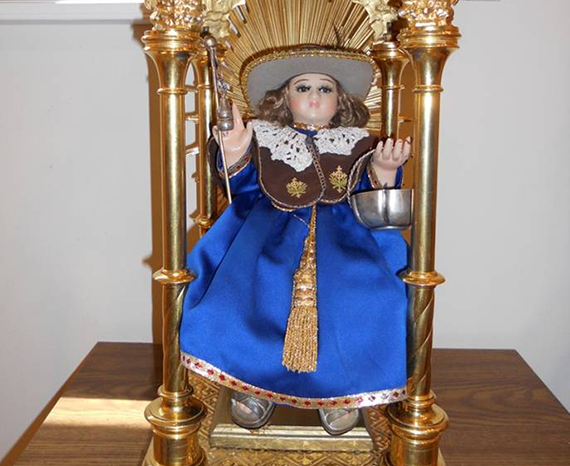El Santo Niño de Atocha: Arrival of icon in Santa Paula eagerly awaited
May 25, 2016
By Peggy Kelly
Santa Paula News
The procession Saturday at 3:00 p.m. will no doubt draw thousands when one of Santa Paula’s favorite saints, El Santo Niño de Atocha returns for a visit to what is now considered the icon’s second sanctuary, Our Lady of Guadalupe Church.
The doll of The Holy Child of Atocha, nicknamed El Niño Azul because its usual garb is blue, depicts the Christ Child and is the Catholic Church’s third-most cherished religious icon in Mexico
This is the 10th year that El Santo Niño has been on loan from its shrine in Plateros, Mexico. The sacred doll is enshrined in Santa Paula to allow visits by pilgrims who cannot travel to Plateros to visit the original and draws worshippers from throughout Southern California, the western states as well as Mexico. The number of visitors and how far they travel to see El Santo Niño de Atocha depends on the icon’s schedule.
“The Little Saint will be in Santa Paula from May 28 to June 5,” City Manager Jaime Fontes told the City Council at the May 16 meeting.
“The closing Mass can draw 5,000 people, as can the opening ceremony…we’ve had over 50,000 people come into Santa Paula,” for the week the icon is at Our Lady of Guadalupe Church.
On Saturday the procession will gather at Harding Park (also home to the Boys & Girls Clubs of Santa Clara Valley Clubhouse), 1400 E. Harvard Blvd. and travel to Our Lady of Guadalupe, 427 N. Oak St. where a Mass and Novena will be held at 6 p.m.
Father Aureo Gerardo Armas Garcia, OFM Basilica of Our Lady of Zapopan, will lead the Novenas.
On Sunday May 29 there will be Masses at 8 and 10 a.m. in English, 11:30 a.m., 1, 4 and 6 p.m. (Novena); Monday, May 30 Masses will be held at 7:30 a.m., noon and 6 p.m. (Novena).
Novena Mass in Spanish will be held weekdays at 7 p.m. and on Saturday June 4 Masses will be held at 9 a.m., noon, 3 p.m. and 6 p.m. On Sunday, June 5 leading up to the 4 p.m. Farewell Mass Masses will be held at 8 and 10 a.m. (English), 11:30 a.m. and 1 p.m. Night Vigil Mass will be at 8 p.m. on the last day of the Novena.
The Sunday, June 5 Farewell Mass will be celebrated by the Most Rev. Jose H. Gomez, the Archbishop of Los Angeles. The Mass will start at 4 p.m. at Las Piedras Park. The procession will leave the church at 3 p.m.
Father Charles Lueras will be busy the week of The Little Saint’s visit: many worshipers bring clothing for the icon to be changed into.
During the processions the tiny wood-and-plaster doll is carried on a bed of flowers and traditionally dressed in Renaissance clothing.
The arrival procession features scores of participants that dance, play instruments, sing and ride horses to accompany El Niño Azul who is carried above the crowd resting on a bed of flowers.
Thousands of people line the streets from Harding Park to the church to hear the bands heavy with brass instruments playing joyous tunes.
Performers come from throughout Southern California, Mexico and beyond and also include Aztec and Folklorico troupes.
The church will be visited all week long by those praying and hoping for the miracles that the El Santo Niño de Atocha is famed for.
The shrine in Plateros is the third most visited in Mexico.
There are two El Santo Niño de Atocha statues; one stays in Mexico while the other travels to the United States.
The history of the icon dates back to the 13th Century when the now lost town of Atocha, Spain, was conquered by invading forces.
The story goes that many Christians were taken prisoner and often denied food by their captors, but the children of those jailed that were under 12 years old were allowed to bring meals. The women of the village prayed before the statue of Our Lady of Atocha — a title under the Blessed Virgin Mary — at a nearby parish to ask her son Jesus Christ for help.
Soon it was reported that an unknown boy dressed in pilgrim’s clothing had begun to bring food to childless prisoners.
When the women heard of the child, they returned to the church to thank the Virgin for her efforts, and noticed that the shoes worn by the Infant Jesus statue held by Our Lady of Atocha were tattered and dusty. No matter how often they were changed the shoes continued to show signs of wear and the people of Atocha interpreted this as a sign that the infant Jesus went out every night to help those in need, which later developed into a devotional Roman Catholic practice.
In Mexico, The Holy Child was credited with helping to save those trapped in a silver mine explosion, the statue’s dirty and tattered clothing and shoes used as proof that the El Santo de Niño was the one who first offered water to and then led the men to safety.
Thereafter, The Holy Child was declared the protector of miners and placed in a special glass box for all to see and celebrate.



